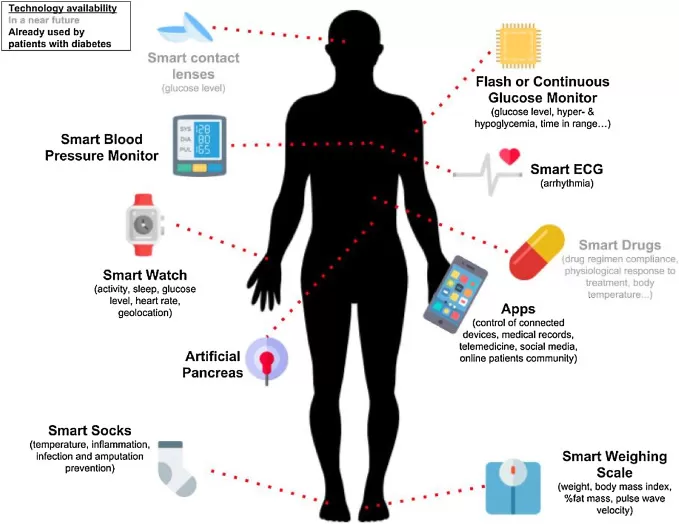Over the last 100 years, the lifestyle of people has dramatically changed. In the past, people used to follow a more healthy diet: food was mostly organic, meals were much smaller and contained far fewer calories than today. Also, previously people used to be physically active the biggest part of the day. In contrast, modern people eat too much, often fast food, and have a lack of physical activity throughout their days. All these contribute to a sedentary lifestyle and obesity, triggering the rise in the number of diabetes cases.
Diabetes management and monitoring require improved access to health care and management and monitoring efforts in particular. Blood glucose level, blood pressure, heart rate, temperature, physical activity, diet, and some other factors should be considered. And with the advent of wearable devices, measuring and monitoring these factors becomes easier than ever.
In this blog post, we will take a look at some of the existing and coming wearable devices that help or have the potential of helping diabetes patients monitor their medical parameters easily and enjoy a healthier life.
Wearables for Patients with Diabetes
The market of wearables is currently valued at a sale of 181.51 million units, and the demand is constantly growing, with new products constantly appearing, like smart fabrics and hearables. When it comes to healthcare, the market is predicted to surpass $29 billion by 2026, compared to $ 6.8 billion in 2017. So there is no doubt that connected devices will play a significant role in the future of healthcare. As to the management and monitoring procedures for patients with diabetes, the beneficial role of wearable devices is already apparent.
Today, people with diabetes can already use a range of connected devices that make their life a bit easier and a bit more relaxed. Such devices allow not just measuring physical activity, heart rate and temperature, but also continuously and effortlessly monitor their blood glucose level, body mass index, pulse wave velocity, sleep, activity, etc., as well as to detect inflammation and the risk of amputation. The variety of wearables is wide, and some of the most known forms existing today or coming in the nearest future are illustrated in the picture below.

Now, let’s look at each of these devices a bit closer.
Flash Continuous Glucose Monitoring Systems
The notion gathers wristbands, smartwatches, skin patches, smart shoes and other types of wearables for glucose monitoring. Nevertheless, the most popular type of flash continuous glucose monitoring systems come in the form of devices that stick to the skin, usually on belly or arm. Such devices measure the glucose level every few minutes, providing their users with the ability to take more control of their health.
Smart Contact Lenses
Although contact lenses are generally used to correct vision, quite soon it will change. The development of new materials and the shift towards minimization of electronics makes it possible for contact lenses to monitor the health of the wearer: for example, monitor blood sugar levels.
There is an existing partnership between Google and pharmaceutical manufacturer Novartis that aims at developing such kind of contact lenses, and offer the opportunity for patients with diabetes to monitor their blood sugar levels in real-time, in the convenience of a mobile device.
Smart Wearable ECG Monitor
One more connected device that brings more convenience in health monitoring to patients with diabetes, as well as people having a family predisposition, history of heart attacks or strokes, high blood pressure, high cholesterol, and excess weight, is wearable ECG Monitor. Existing devices such as Quardiocore measure skin temperature, heart rate and heart rate variability, respiratory rate and activity, analyzing these factors and providing its users with valuable, potentially life-saving insights.
Smart Pill
This device aims at freeing people with diabetes from such annoying experience as taking insulin injections multiple times a day. The pill is to be about the size of a small berry and will provide insulin with the help of a small needle.
Smart Watch
There is a wide range of smart watches existing today, and there are smart watches designed especially for people who want to take control of their glucose level. Using biosensors, such devices measure the level of glucose painlessly, throughout the day and night. The results of these measurements are conveniently displayed on the watch screen.
Artificial Pancreas System
The system aims at helping people with T1D to keep blood sugar levels normal, constantly monitoring blood-glucose levels and using an algorithm to automatically provide the right amount of insulin at the right time.
Smart Socks
There are various types of smart socks developed, including those for patients with diabetes that allow measuring the level of insulin with the help of biosensors, as well as to measure temperature and inflammation. The best thing is that such wearables allow doctors to monitor their patients remotely and know immediately if some health parameters signalize that there is a problem that requires medical intervention.
Smart Weighing Scale
Because complications related to diabetes are very serious, patients need to monitor their weight to minimize the risk of heart disease and better their blood sugar levels. Smart weighing scale provides information on BMI, visceral fat, water, as well as bone mass and muscle mass.
The Bottom Line
Although wearables are considered to be comparatively new kind of devices, they has already made their way and proved their value in healthcare, and for people living with diabetes in particular. As the technology grows, it shows that there are new, and more effective ways for monitoring the disease and helping people who struggle with it make their lives a bit more relaxed.
At Elinext, we put great emphasis on developing smart and effective solutions that connect such devices, allowing to bring together all the important information for healthier and more accurate results. Contact us with any question, and thank you for reading.









